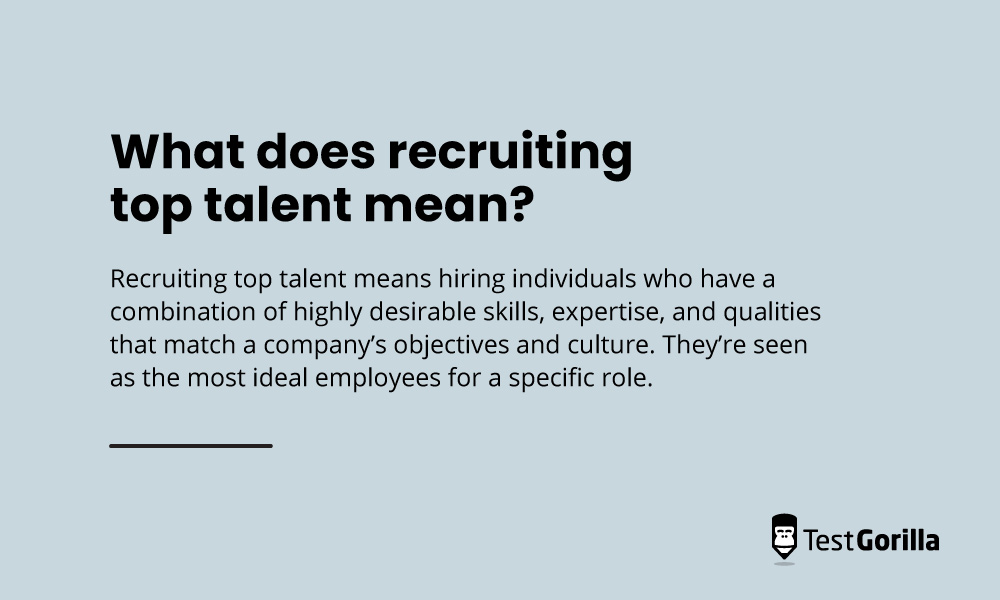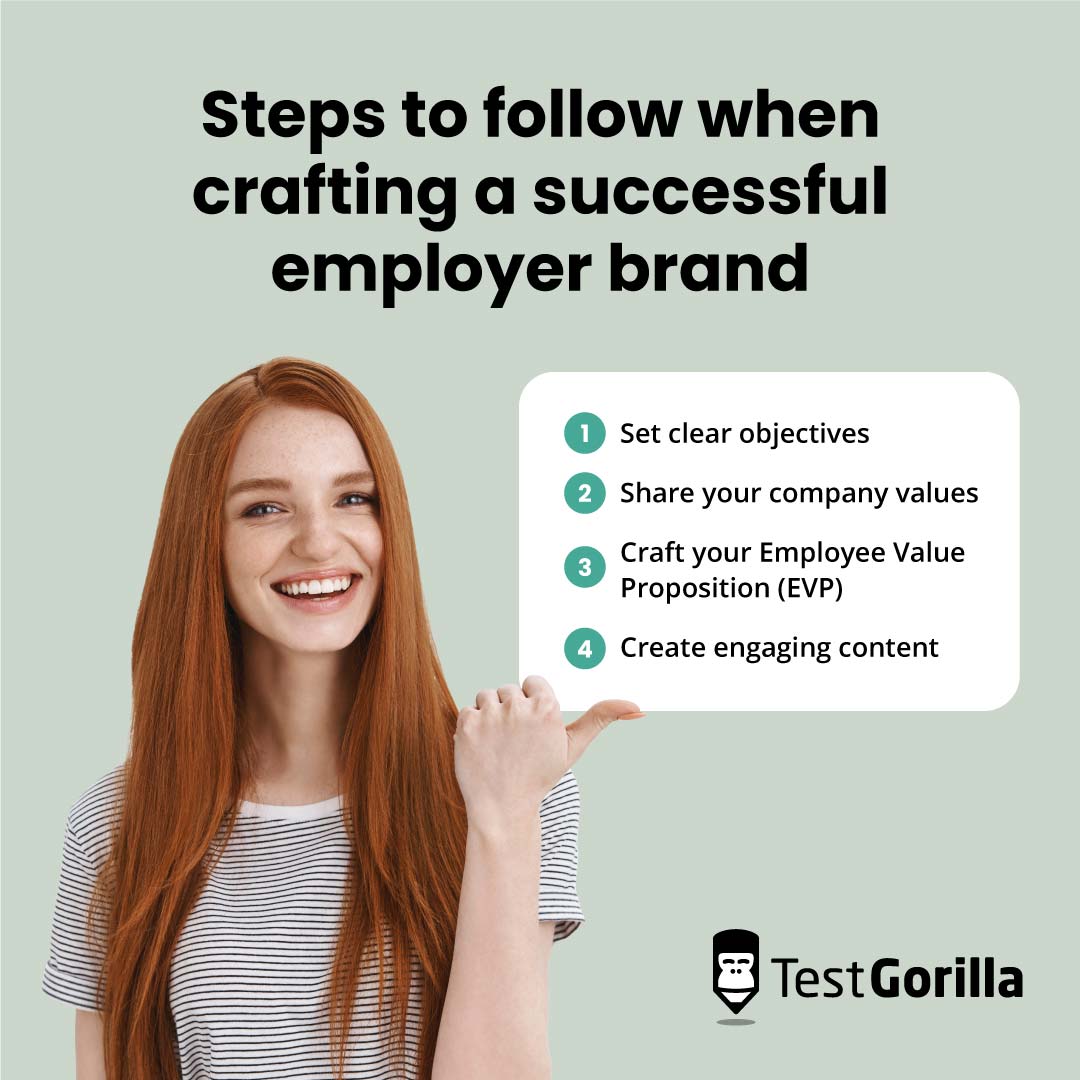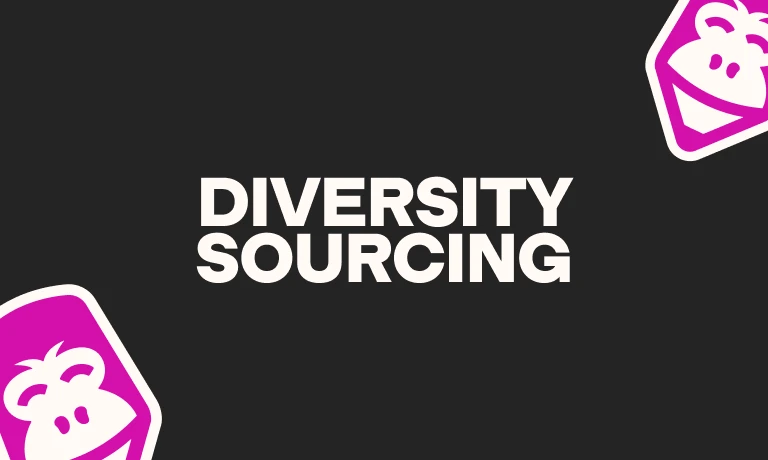Recruiting top talent: 13 proven tips for hiring the best candidates
Are you settling with “filling seats” because you’re under pressure from higher-ups and understaffed teams?
Recruiting top talent is something every hiring manager wants to do. But the above scenario unfolds more often than we’d like to admit.
The result?
A mis-hire, a dent in the budget, and back to square one in the hiring process.
But what if there was a way to break free from this vicious cycle?
It’s possible to construct a hiring process so robust that it magnetically attracts high-quality talent, saving you both time and resources.
In this article, you’ll learn 13 proven tips for recruiting top talent, including using a variety of talent assessments, to turn your hiring process into a strategic system for attracting top candidates.
What does recruiting top talent mean?
Recruiting top talent means hiring individuals who have a combination of highly desirable skills, expertise, and qualities that match a company’s objectives and culture. They’re seen as the most ideal employees for a specific role.
Compared to more junior candidates, top talent typically has a proven track record of high performance, exhibits leadership skills, and brings innovative solutions and perspectives to the team.
They’re also more engaged in their role, making them more invested in their position and likely to stay longer and move into leadership positions.
Higher engagement means higher customer satisfaction and loyalty if those top candidates are in customer-facing roles. Companies with a terrific customer experience have employees who are 1.5 times more engaged than average workers.[1]
But how do you attract, recruit, and retain top talent?
The next section describes our 13 best tips for recruiting talent for your company.
How to recruit top talent: Our 13 best strategies
The table below summarizes 13 of the best ways to recruit top talent into your organization.
These aren’t the only tips you can use, but they’re the most important when it comes to attracting the right candidates.
Tip | Biggest benefit |
1. Create a positive company culture | Attracts and retains top talent by fostering a supportive and motivating environment. |
2. Implement a robust onboarding process | Ensures new hires are set up for success, reducing early turnover and boosting productivity. |
3. Offer competitive compensation and benefits | Makes the company more appealing to top candidates, ensuring you attract the best in the market. |
4. Determine your most efficient sourcing channels and prioritize them | Maximizes recruitment efficiency and ensures you're reaching the right talent pools. |
5. Use talent assessments/skills-based practices | Ensures candidates have the necessary skills, reducing the risk of bad hires. |
6. Build a talent pipeline and manage it | Provides a steady stream of qualified candidates, reducing time-to-hire. |
7. Create a great candidate experience | Increases acceptance rates by making candidates feel valued and respected. |
8. Extend offers quickly | Reduces the chance of losing top candidates to other offers. |
9. Hire for culture add instead of culture fit | Brings diverse perspectives and drives innovation, enriching the company culture. |
10. Leverage internal recruitment | Uses existing talent and knowledge, saving on recruitment costs and time. |
11. Offer flexible and remote work | Appeals to a broader range of candidates, especially those seeking work-life balance. |
12. Use data-driven recruitment | Improves recruitment strategies by basing decisions on actual data, not just intuition. |
13. Develop employer branding | Differentiates the company in the job market, attracting candidates who align with your values. |
Let’s dive into each of these in more detail.
1. Create a positive company culture
Company culture plays a pivotal role in attracting top-notch candidates who demand a supportive and engaging work environment.
According to a Glassdoor survey, 77% of people would consider a company's culture before applying for a job there.
Two key elements of a positive company culture are vision and recognition.
Vision: A clear and inspiring vision can motivate employees and attract like-minded candidates.
Recognition: Recognizing and rewarding employee efforts and achievements goes a long way toward retaining top talent. This includes peer-to-peer recognition.
Google’s culture of innovation and employee freedom appeals to many ambitious professionals.
According to its own About page, Google has always been driven by a mission that transcends the ordinary: to organize the world's information and make it universally accessible and useful.
Google's vibrant culture acts as a potent magnet for top talent, because it emphasizes freedom, diversity, and inclusion.
For more on why culture and strategic hiring matter, read our in-depth analysis on the great talent heist, which explores how the strongest defense against poaching is creating environments people don’t want to leave.
2. Implement a robust onboarding process
Onboarding means bringing a newly hired individual into your company, and its culture, and providing them with what they need to succeed in their role
Onboarding is critical for recruiting top talent – you need to have a rock-solid onboarding process or you risk losing the hire sooner rather than later.
Here are a few things you can do to improve your new employee onboarding.
Engage early and often. This means maintaining open communication from the moment potential hires engage with your company. Top talent appreciates the extra effort made to keep in touch throughout the hiring process.
Set clear expectations. Make it clear what your new employees have to do from day one. You want to make sure there’s no confusion about their role and what they’re expected to achieve in the short and long term.
Establish and communicate goals. For example, a 30-60-90 day plan would be ideal here, where you take your new hire through a goal-setting process for their first 3 months with your organization.
Onboarding best practices ensure top talent feel like they’re welcome at your company and you’re doing everything you can to help them.
On the other hand, poor onboarding can lead to quiet quitting, which has become more common since the pandemic.
For example, one thing you can do to improve your onboarding process is to use an onboarding checklist.
With a checklist, you’re able to streamline your onboarding process, ensuring efficiency and promoting a high level of connectedness in new employees. A checklist also helps you encourage open communication, boost cultural familiarization, reduce turnover costs, and provide clarity in roles. In turn, this enhances employee satisfaction and retention.
Check out our article on new employee onboarding for more guidance on this.
3. Offer competitive compensation and benefits
According to MetLife, only 61% of employees are satisfied with their benefits, the lowest number in the past decade.
Companies must use competitive compensation and benefits as a strategy to attract top talent.
If you’re looking to hire the best, you need to offer attractive pay and the right perks. After all, the best candidates expect above-average compensation.
Not only do you attract the right people to your company by offering attractive compensation and benefits, but you also reduce turnover in the long run.
Here’s how you can use benefits and compensation to attract top talent:
Research pay structures: Make sure your chosen pay structure aligns with your company’s growth plans and has the flexibility to attract top talent.
Decide how to determine raises: Implement a professional development plan for awarding pay increases over time to compensate for experience and to stay competitive.
Practice regular benchmarking: Regularly evaluate current employee salaries against the industry standard. Adjust salaries to ensure fair compensation.
Communicate with employees: Be transparent about how salaries and raises are determined.
Check out this article on compensation and benefits for more information.
4. Determine and prioritize your most effective sourcing and recruitment channels
Knowing how to prioritize sourcing and recruitment channels can make or break your top talent recruitment strategy.
Sourcing is different from recruiting. Sourcing means actively looking for top talent. Recruiting means bringing that talent on board, conducting interviews, and offering them a position with your company.
Think of it like inbound vs outbound marketing. Inbound means getting top talent to come to you through ads and content marketing. Outbound means you’re reaching out to them through methods like headhunting for passive candidates.
Here are some channels for sourcing top talent:
Job boards
LinkedIn
Forums
Networking
Referrals
Rather than spreading yourself too thin and exhausting your budget in every channel, figure out which ones bring you the best talent and then double down on those.
Two important things to keep in mind:
Make sure you keep track of key sourcing metrics like sourcing channel effectiveness, candidate pipeline speed, and candidate conversion rate. This data should tell you where you’re getting high-performing candidates from.
Your best sourcing channels are likely to change based on role, department, and industry. So avoid reliance on the same sources across your entire company.
For more information on how to source the best, check out this step-by-step guide on candidate sourcing.
5. Use talent assessments and skills-based hiring practices
More and more research is proving the relative ineffectiveness of traditional recruitment methods, especially when compared to the more objective approach of skills-based hiring practices.
While traditional approaches can work, their overreliance on resumes, work experience, and unstructured interviews are far less objective, more expensive, and more restrictive of your talent pool.
According to TestGorilla’s The State of Skills-Based Hiring 2024 report, 94% of employers agree that skills-based hiring is better at predicting job success than resumes.
Talent assessments are a powerful tool for evaluating a candidate's skills, competencies, and aptitude.
Some examples of assessments and tests include:
Skill assessments: These examine both power skills (e.g., time management and innovation) and hard skills (e.g., Agile methodology, SEO best practices). Cognitive ability tests: These help assess crucial skills like adaptability and learning speed, which are essential in the era of AI and rapid changes in all industries.
Personality and culture tests: These talent assessments evaluate key personality traits and cultural fit, also helping to assess motivation among potential candidates.
Here’s how you can start using talent assessments to hire quality candidates:
Define objectives and criteria: Understand what “top talent” means to your company and determine how to measure these skills.
Establish an effective hiring process: Use data-driven, well-structured methods to build your process, including building skills-based job descriptions and adopting structured interviews.
Set clear expectations: Clarify which skills need to be assessed, how results will be used, and the required skill levels.
Review the results: Use talent assessment tools to shortlist candidates by test score and examine the highest-scoring candidates individually.
It’s likely that skills-based assessments will become the go-to hiring method in the near future. Make sure you adapt now so your company is positioned to take advantage of this in the years to come.
6. Build a talent pipeline and manage it
A talent pipeline is a pool of qualified candidates that you can reach out to when suitable roles become available.
Like a great sourcing channel (as mentioned earlier), a talent pipeline can bring you the best candidates for a role if you set it up correctly.
This way, hiring becomes more efficient and proactive.
Let's dive into the process of building and managing a talent pipeline for your organization.
Start by analyzing the skills gap within your company. Determine the abilities your current workforce possesses and identify areas where additional skills are needed. This can help you determine which roles need to be filled and create an ideal candidate profile (ICP) for those positions.
Leverage talent acquisition analytics to gain insights into your hiring process. You’ll be able to fine-tune your recruitment strategies and make better decisions as your needs evolve.
Don't forget about internal recruitment. The best person for the role might be right under your nose.
Reconnect with former employees who have left the organization on good terms. Make sure they fit your definition of top talent. They may be interested in rejoining the team or even referring other qualified candidates to fill open positions.
As a final strategy, be sure to stay in touch with your pipeline and share relevant industry news and opportunities. You also need to reassess your talent pipeline regularly to ensure it continues to bring you top talent.
7. Create a great candidate experience
A positive candidate experience is crucial for attracting and recruiting top talent.
It encompasses all interactions between job seekers and your company throughout the hiring process, from viewing job listings to the onboarding phase.
To provide a great candidate experience to attract top talent, here are steps you can take:
Remember that the onus is on you and your company to proactively promote your terrific candidate experience. Top talent, unlike average candidates, are likely to be interviewing at several companies at once and getting more than one offer. You have to make sure you’re spreading the word so high-performing candidates hear about your company.
Ensure your job listings are easy to find and engaging. This helps pique the interest of prospective candidates who may be seeking new opportunities.
Keep the application process simple and user-friendly. This encourages candidates to apply and reduces the chances of them feeling overwhelmed.
Maintain thorough communication throughout the hiring process. This helps to build trust and makes candidates feel valued.
Make interviews a pleasant experience for candidates. This includes providing clear information on what to expect during the interviews and being respectful of their time.
Remember the importance of proper onboarding. Once a candidate is offered a position, continue to provide support and guidance as they transition into their new role.
Yes, the above points apply to your hiring process in general.
But if you want to hire the best, you need to double down on making sure it’s an enjoyable experience from start to finish.
8. Extend offers quickly
When finding top talent, it's crucial to extend offers quickly to avoid losing your candidate to another employer – and signal to the candidate that you’re genuinely excited to work with them.
Remember, top talent often find themselves juggling multiple offers. Offering an attractive proposal in a timely manner can be the deciding factor in favoring your organization over others.
Extending offers quickly has the added benefit of massively improving hiring efficiency.
Here are 10 tips for making job offers to attract top talent:
Start compensation conversations early
Be candid and upfront
Build a relationship during hiring
Base the salary on knowledge and skills
Explain additional incentives and perks
Emphasize culture and growth opportunities
Include popular benefits
Ask the candidates what they want
Consider special requests from the candidate
Have a follow-up conversation
When you take too long to extend an offer, you risk losing candidates whose interest in your company fades as they continue their job search. Or because they accepted a competitor’s offer.
On the other hand, extending offers quickly and in writing to your best candidates demonstrates your organization's eagerness to bring on capable employees.
9. Hire for culture add instead of culture fit
When attracting top talent, you should prioritize candidates who can contribute meaningfully to your company's culture.
This means choosing a culture add vs. culture fit model.
The ‘Culture Add’ approach focuses on selecting candidates who bring distinctive, enriching elements to your existing culture.
These candidates often have diverse perspectives, ideas, and experiences that can enhance the overall environment, setting them apart from those who might simply conform to the status quo.
The traditional ‘Culture Fit’ model, on the other hand, tends to maintain homogeneity.
And it can hinder progress by only hiring candidates who blend seamlessly with the current organizational climate.
Your hiring and interview process should reflect your commitment to building a positive culture that values diversity and inclusion. One way to do this is by using recruitment tools, such as a Culture Add test designed to assess candidates based on their potential cultural contributions.
A Culture Add test is designed to help identify top talent who align with your organization's values and exhibit the behaviors that would make them successful in their roles.
10. Leverage internal recruitment
Internal recruitment can significantly boost the process of hiring top talent and should not be overlooked.
After all, the best candidate for the role might be closer to home than you think.
And an impressive 81% of hiring professionals agree that internal recruiting improves employee retention.
Here are some steps you can use to leverage internal recruitment for hiring top talent:
Create a quick-access skills database: Centralize your employees' skills, qualifications, and interests in an easily accessible database. This streamlined repository helps you identify top internal candidates with the right skill sets for open positions. A skills gap analysis works well here for the right people.
Remove unconscious bias from your recruitment process: Promote equal opportunities and fairness within your organization using standardized assessments.
Develop an internal talent pool: Proactively identify potential internal candidates for career growth and future roles. Nurture their skills through training, mentorship, or other development methods to prepare them for future opportunities.
Facilitate career pathing: Help your employees map out their ideal career paths with professional development plans. Encourage them to develop the necessary skills and expertise to grow within their chosen trajectories.
Recruiting from within sends a positive message to your current employees. It’s also much faster to hire from within your own company because you don’t have to invest as much time (or money) into onboarding or training.
11. Offer flexible and remote work
As the job market continues to evolve, so do the expectations of employees.
With the increasing popularity of remote work and flexible hours, your company can stay competitive and attract top talent by implementing these practices.
Remote work has several advantages that not only benefit employees, but also employers.
By hiring remote employees, you gain access to a global pool of skilled candidates that you might have missed out on otherwise, including individuals from rural areas or other countries, and those looking for a better work-life balance.
Another way to offer flexibility to your employees is through a Results-Only Work Environment (ROWE).
In a ROWE, employees can come into the office at their own discretion as long as they deliver the expected outcomes. This type of arrangement encourages a healthy work-life balance and allows employees to focus on what truly matters – their results.
Obviously, top talent gives you the best results. So you want to make sure you’re helping them focus on these outcomes.
Revolut is a company that has taken this idea to heart.
Its official “work-from-abroad” policy means each employee (with prior HR permission) is allowed to work for up to 60 days from another pre-approved country.
Not only do these perks offer the opportunity for a better work-life balance, but they also enable employees to explore new locations and experiences without sacrificing their careers.
12. Use data-driven recruitment
Your goal should be to hire the right candidates every single time.
Through data-driven recruitment, which involves leveraging tools like applicant tracking systems and survey software to analyze vast talent pools, you can identify candidates with the best skills, experience, and mindset to help your organization excel.
Data-driven recruitment captures important data at each stage of the hiring process, promoting a data-first approach in the sourcing, selection process, and recruitment planning, as well as measuring hiring efficiency.
This means hiring teams can then filter and evaluate huge candidate pools through an objective lens and come out with the best candidates for a specific role.
One way this can be done is through tracking talent sources – such as job boards, career pages, or social media – to find out which ones yield top talent.
Microsoft is an excellent example of a company leveraging data-driven recruitment to its advantage.[2]
In The Microsoft Candidate Experience, Microsoft uses data to understand the candidate's journey from application to onboarding.
Feedback is collected at various stages to identify areas of improvement. By analyzing this data, it can improve the candidate experience, which in turn improves its employer brand and attracts top talent.
13. Develop employer branding to recruit top talent
Employer branding is a pivotal strategy in hiring top talent.
It also plays a role in how your company is perceived in the job market.
Think of it as a comprehensive representation of a company through the lens of an employee. It reflects the values, culture, and developmental opportunities a company offers to its people.
To craft a successful employer brand, follow these steps:
Set clear objectives: Determine what you want to achieve with your employer branding efforts. Since we’re looking to attract top talent here, you can build a strategy around this goal by crafting a brand that high-performing people would be proud to work for.
Share your company values: Make sure to emphasize your company's core values, mission, and culture in your branding efforts. These elements effectively communicate who you are as an employer and what you stand for.
Craft your Employee Value Proposition (EVP): Your EVP is a unique combination of benefits, growth opportunities, and the work environment your company provides. And yes, you need to have a compelling EVP to persuade top talent to join your team. Don't forget to emphasize flexibility and inclusiveness as part of your EVP.
Create engaging content: Share employee testimonials, success stories, and behind-the-scenes glimpses of your company culture on various platforms to grab the attention of potential candidates.
Developing a strong employer brand not only attracts top talent but also helps you retain existing employees and reduce turnover. Remember, talented job seekers have options.
The best insights on HR and recruitment, delivered to your inbox.
Biweekly updates. No spam. Unsubscribe any time.
Use these 13 tips for recruiting top talent
Recruiting top talent doesn’t have to be a headache. But you do need to proactively build systems into your hiring and onboarding process to do it effectively.
We’ve covered some of the most important tips for top talent recruitment in this article.
These tips revolve around providing an amazing candidate experience and making sure these candidates know how much you value their contributions.
Once you integrate these practices into your recruiting, you’re sure to find that sourcing and recruiting top talent becomes a repeatable practice.
To ensure you’re hiring great candidates who can add to your culture and align well with it, consider using our Culture Add test.
And don’t forget to read some of our other articles on bridging the talent gap and using adjacent skills to solve skills gaps.
Sources
Duncan, Ewan, et al. (July 1, 2016). “Customer experience: Creating value through transforming customer journeys”. McKinsey & Company. Retrieved October 25, 2023. https://www.mckinsey.com/capabilities/growth-marketing-and-sales/our-insights/customer-experience-creating-value-through-transforming-customer-journeys
Green, David. (August 3, 2021). “Microsoft's Chief People Officer on Creating a Data Driven Culture in HR (Interview with Kathleen Hogan)”. myHRfuture. Retrieved October 19, 2023. https://www.myhrfuture.com/digital-hr-leaders-podcast/2021/8/3/microsofts-chief-people-officer-on-creating-a-data-driven-culture
Related posts
You've scrolled this far
Why not try TestGorilla for free, and see what happens when you put skills first.





















